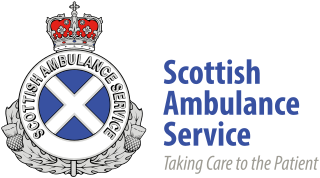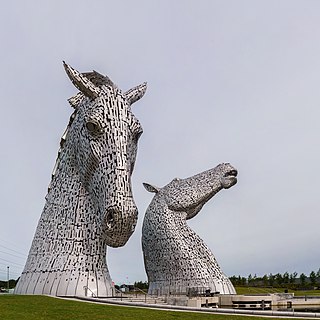
The Forth and Clyde Canal is a canal opened in 1790, crossing central Scotland; it provided a route for the seagoing vessels of the day between the Firth of Forth and the Firth of Clyde at the narrowest part of the Scottish Lowlands. This allowed navigation from Edinburgh on the east coast to the port of Glasgow on the west coast. The canal is 35 miles (56 km) long and it runs from the River Carron at Grangemouth to the River Clyde at Bowling, and had an important basin at Port Dundas in Glasgow.

The Crinan Canal between Crinan and Ardrishaig in Argyll and Bute in the west of Scotland is operated by Scottish Canals. The canal, which opened in 1801, takes its name from the village of Crinan at its western end. Approximately nine miles (14 km) long, the canal connects the village of Ardrishaig on Loch Gilp with the Sound of Jura, providing a navigable route between the Clyde and the Inner Hebrides, without the need for a long diversion around the Kintyre peninsula, and in particular the exposed Mull of Kintyre.

Falkirk is a town in the Central Lowlands of Scotland, historically within the county of Stirlingshire. It lies in the Forth Valley, 23+1⁄2 miles northwest of Edinburgh and 20+1⁄2 miles (33 km) northeast of Glasgow.

The Falkirk Wheel is a rotating boat lift in Tamfourhill, Falkirk, in central Scotland, connecting the Forth and Clyde Canal with the Union Canal. It reconnects the two canals for the first time since the 1930s. It opened in 2002 as part of the Millennium Link project.

The Union Canal, full name the Edinburgh and Glasgow Union Canal, is a canal in Scotland, running from Falkirk to Edinburgh, constructed to bring minerals, especially coal, to the capital. It was opened in 1822 and was initially successful, but the construction of railways, particularly the Edinburgh and Glasgow Railway, which opened in 1842, diminished its value as a transport medium. It fell into slow commercial decline and was closed to commercial traffic in 1933. It was officially closed in 1965. The canal is listed as three individual scheduled monuments by Historic Scotland according to the three former counties, Midlothian, West Lothian and Stirlingshire, through which it flows.

The Scottish Ambulance Service is part of NHS Scotland, which serves all of Scotland's population. The Scottish Ambulance Service is governed by a special health board and is funded directly by the Health and Social Care Directorates of the Scottish Government.
Patrick Travers was a Scottish football player and manager in the first half of the 20th century. He played for many clubs in his native Scotland and for Barnsley in England, before becoming involved in coaching, and later, management, winning the Scottish Cup with Clyde on two occasions either side of World War II.
The Millennium Link is one of the biggest engineering projects ever undertaken by British Waterways. The Union Canal and the Forth & Clyde Canal were originally joined by a flight of locks. The Millennium Link project replaced the locks with a boat lift, the Falkirk Wheel.

The Helix was a land transformation project to improve the connections between and around 16 communities in Falkirk Council, Scotland, including the eastern end of the Forth and Clyde Canal, and to regenerate the area near where the canal joins the River Carron. The most visible feature of the development is the two unique equine sculptures known as The Kelpies.
Dominick Sullivan, is a Scottish former football midfielder.
Seagull Trust Cruises is a waterway society and Scottish charity.
Thomas McMillan is a Scottish former professional football defender who played for Aberdeen and Falkirk.

The Canal & River Trust (CRT), branded as Glandŵr Cymru in Wales, holds the guardianship of 2,000 miles of canals and rivers, together with reservoirs and a wide range of heritage buildings and structures, in England and Wales. Launched on 12 July 2012, the Trust took over the responsibilities of the state-owned British Waterways in those two places.

Scottish Canals is the Scottish Government body responsible for managing the country's inland waterways. Formerly a division of British Waterways, it became a stand-alone corporation on 2 July 2012, then an executive non-departmental public body of the Scottish Government in April 2020.

The Kelpies are 30-metre-high (98 ft) horse-head sculptures depicting kelpies, located between Falkirk and Grangemouth, but the Kelpies themselves are situated in Grangemouth, standing next to an extension to the Forth and Clyde Canal, and near the River Carron, in The Helix, a parkland project built to connect sixteen communities in the Falkirk Council Area, Scotland. The sculptures were designed by sculptor Andy Scott and were completed in October 2013. The sculptures form a gateway at the eastern entrance to the Forth and Clyde canal, and the canal extension built as part of The Helix land transformation project. For a short time, they were the tallest equine statues in the world until Pegasus and Dragon was completed the following year.

The 2014 Scottish League Cup final was the 68th final of the Scottish League Cup. The final took place on 16 March 2014 at Celtic Park, Glasgow. The clubs contesting the 2014 final were Scottish Premiership clubs, Aberdeen and Inverness CT. This was the first major final for Inverness CT.

Arnold Clark is a car dealer based in Glasgow, Scotland. As of 2022, the company has 193 dealerships across the United Kingdom.












